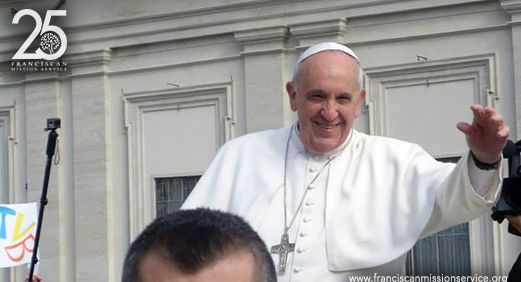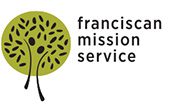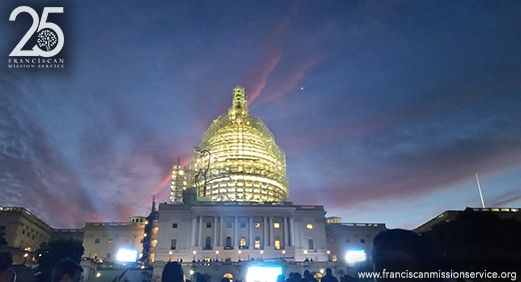On the Steps of the Basilica

Editor’s Note: Communications associate Maria Beben reflects back on Pope Francis’ visit
“The Pope is coming to DC!”
I remember hearing this announcement during my senior year of college at The Catholic University of America. Although I was excited by the idea, I assumed I wouldn’t be in DC to see him.
Barely four months before the Canonization Mass, I had walked up the same steps where Pope Francis celebrated the Mass to receive my diploma with absolutely no idea where I was going to end up and almost a 100% certainty that I wouldn’t be back in DC for a very long time.
So believe me, I was more surprised than anybody when only months later, I was one of the thousands assembled for the Canonization Mass of Junipero Serra.
My initial excitement of being at the Mass was shorter lived than it probably should have been. It was at least 80 degrees outside and I could actually feel the progression of the sunburn as it settled in.
According to those in charge, everyone needed to be through security and in their respective sections by 3pm. At 3:15pm, I hadn’t even made it through security yet. The mass started at 4:15pm. People around me were starting to joke that we wouldn’t make it inside. By 4pm, this joke wasn’t funny anymore. We had been stopped only feet away from the basilica and were told that admittance was “temporarily closed.”
After this announcement, I expected people to lose it. However, I was surprised and moved when the people around me didn’t really react. Many of them admitted that getting mad wasn’t going to change anything. Out of the whole crowd of about 100 people, only one man began to shout at the police officers (as if that’s ever a good idea.) Instead of the crowd joining in, they calmed the man down. For me, the crowd was an example of the Pope’s effect on people. Without even being in our line of sight, he still had an impact. I could see his message of peace and acceptance being lived out in the people around me that day.
Since I’d already had the incredible opportunity to see Pope Francis up close in Rome, this visit wasn’t about the attempted Pope selfies, it was about his presence, his words, and his actions. The Mass was beautiful and although I couldn’t understand 90% of it, I’m so grateful that I got to be part of it.
The next morning, my housemates and I trekked to the Capitol to watch Pope Francis’ highly anticipated address to Congress from the West Lawn. For me, this event was even more memorable than the Canonization Mass (and not just because the address was in English.) That day, I was constantly impressed by the historical nature of the moment. The Pope. In DC. Addressing Congress. I’ll never forget that day.
The week after his visit, I attended a lecture at Georgetown titled “The Francis Factor.” The panelists included former spokesperson for the USCCB Kim Daniels, president and CEO of Foundations and Donors Interested in Catholic Activities Alexia Kelley, contributor for NPR Cokie Roberts, national columnist Mark Shields, and New York Times columnist David Brooks.
There was a large turnout for the lecture, something which in and of itself speaks to “The Francis Factor.” “People don’t want it to be over,” said panelist member Mark Shields.
One of the most important takeaways from the night was that change, any change, takes time. Yes, his visit had and will continue to have an impact, but no, this change will not happen overnight. In fact, it may and probably will take years for the impact of his visit to be fully realized.
Until then, however, Pope Francis’ message is clear. We all have a responsibility. As human beings, we are called to love. We are called to listen. We are called to understand. We are not called to judge and we are not called to condemn. Regardless of age, gender, race, and religion, we are all called to follow the Golden Rule.
*Featured image from Maria’s semester abroad in Rome
Tagged in:

